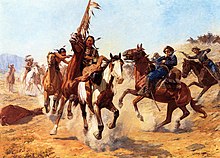Charles Schreyvogel (January 4, 1861 – January 27, 1912) was an American painter of Western subject matter in the days of the disappearing frontier. Schreyvogel was especially interested in military life.


Life edit
He was born in Hoboken, New Jersey to Paul and Theresa Schreyvogel,[1] and grew up in a poor family of German immigrant shopkeepers on the Lower East Side of New York. Schreyvogel was unable to afford art classes and he taught himself to draw.
When Buffalo Bill Cody's Wild West show came to Brooklyn in 1894, Schreyvogel visited to sketch.[2] He went on to become famous for his depictions of the American West, although he did much of his work in his studio (or its rooftop) in decidedly non-Western Hoboken.[3]
In 1901, his painting My Bunkie was awarded the Thomas Clarke Prize at the annual exhibition of the National Academy of Design.[4] He suddenly became recognized and earned what seemed like overnight fame.
He died in Hoboken in 1912 and is buried in Flower Hill Cemetery, North Bergen, New Jersey.[5]
Works by Schreyvogel are included in the collections of the National Cowboy & Western Heritage Museum, Oklahoma City, Oklahoma,[6] the Sid Richardson Museum, Fort Worth, Texas, the Metropolitan Museum of Art, and the Gilcrease Museum, Tulsa, Oklahoma.
See also edit
- Charles Marion Russell, western artist
- J. K. Ralston, western artist
- Frederic Remington, western artist
Notes edit
- James D. Horan. The Life And Art Of Charles Schreyvogel: Painter-Historian Of The Indian-Fighting Army Of The American West. New York: Crown Publishers Inc., 1969.
- Rick Stewart. The American West: Legendary Artists of the Frontier. Hawthorne Publishing Company, 1986.
References edit
- ^ Schreyvogel, Charles, in Who's Who in America (1901-1902 edition), via archive.org
- ^ Bonner, Robert E. (Spring 2011). "'Not an imaginary picture altogether, but parts': The Artistic Legacy of Buffalo Bill Cody". Montana The Magazine of Western History. 61 (1): 50. Retrieved 5 December 2023.
- ^ Hughes, Robert. "How The West Was Spun", Time, May 13, 1991. Accessed August 14, 2007. "It is of Charles Schreyvogel, a turn-of-the- century Wild West illustrator, painting in the open air. His subject crouches alertly before him: a cowboy pointing a six-gun. They are on the flat roof of an apartment building in Hoboken, N.J."
- ^ Charles Schreyvogel Papers, National Cowboy & Western Heritage Museum. Accessed August 14, 2007.
- ^ Project Remember, p. 42
- ^ William S. and Ann Atherton Art of the American West Gallery Archived September 26, 2007, at the Wayback Machine, National Cowboy & Western Heritage Museum. Accessed August 14, 2007.